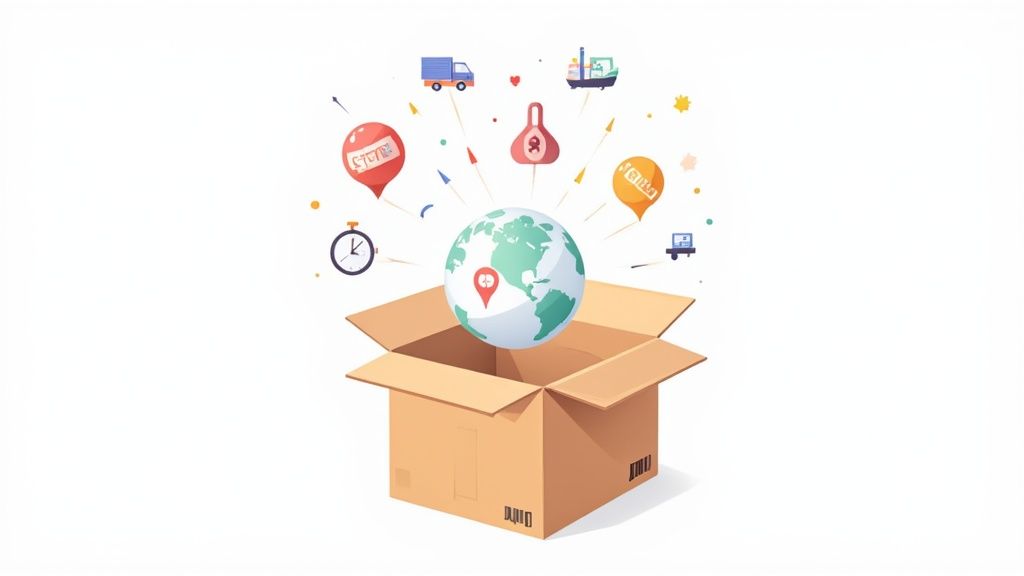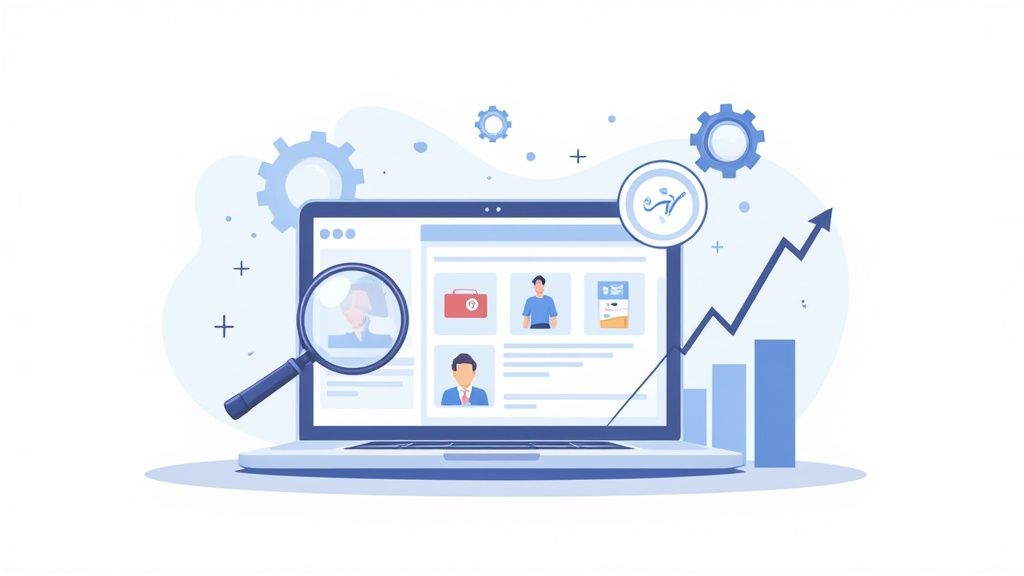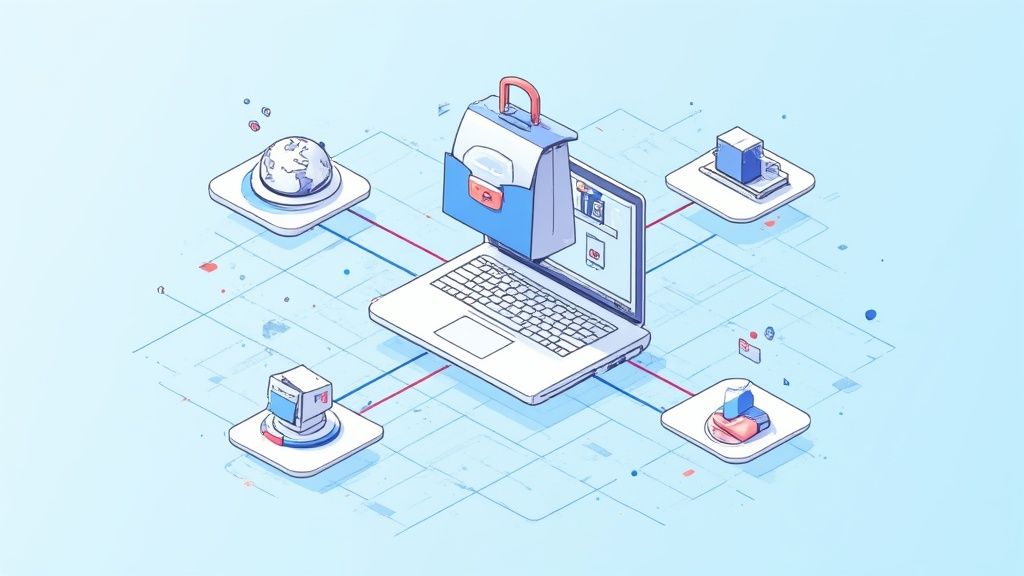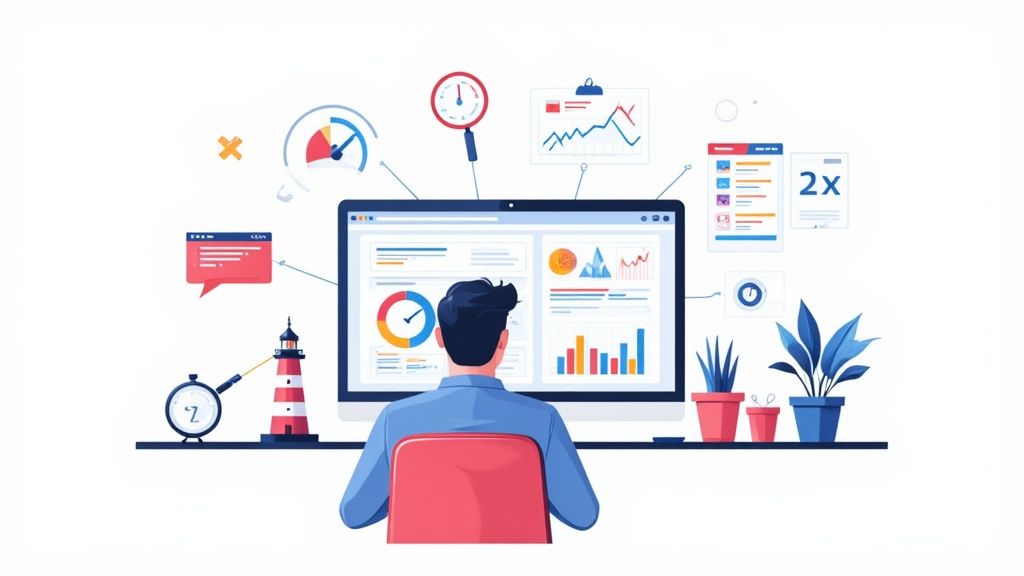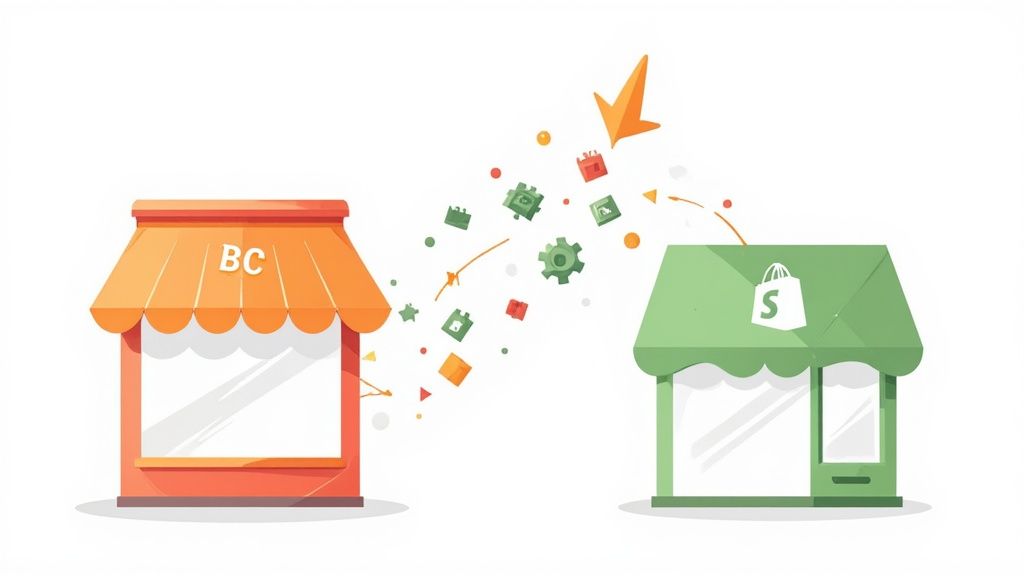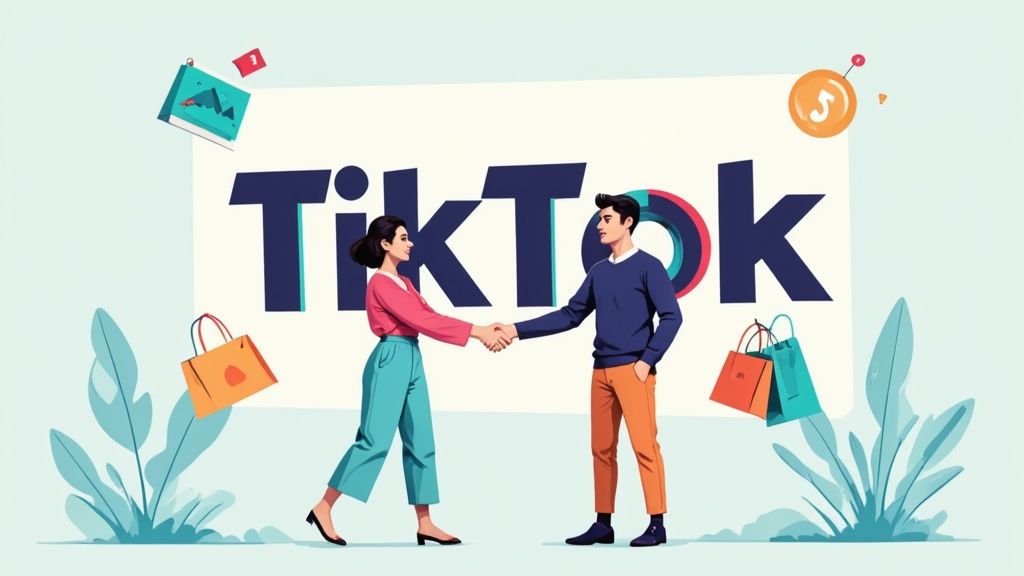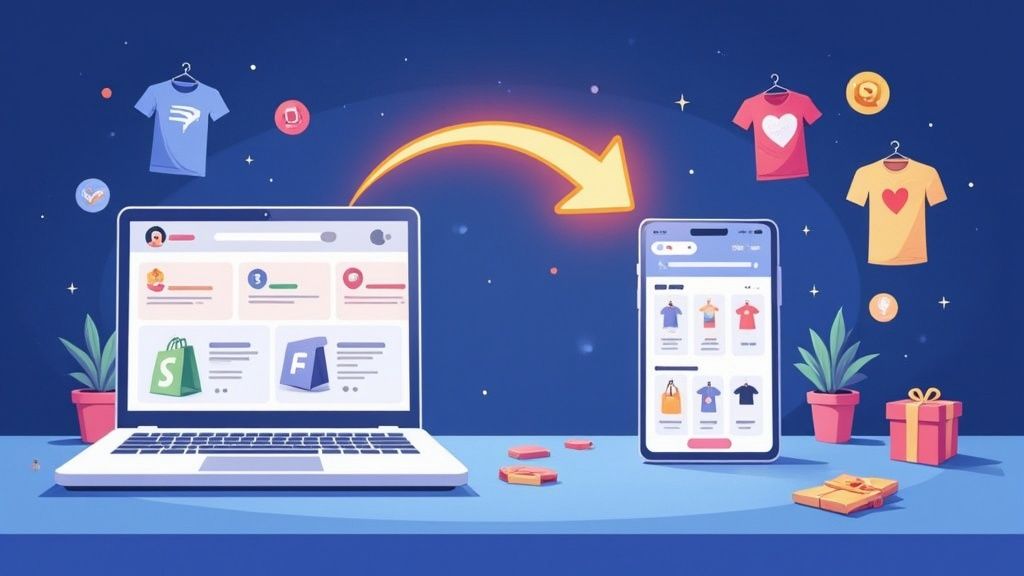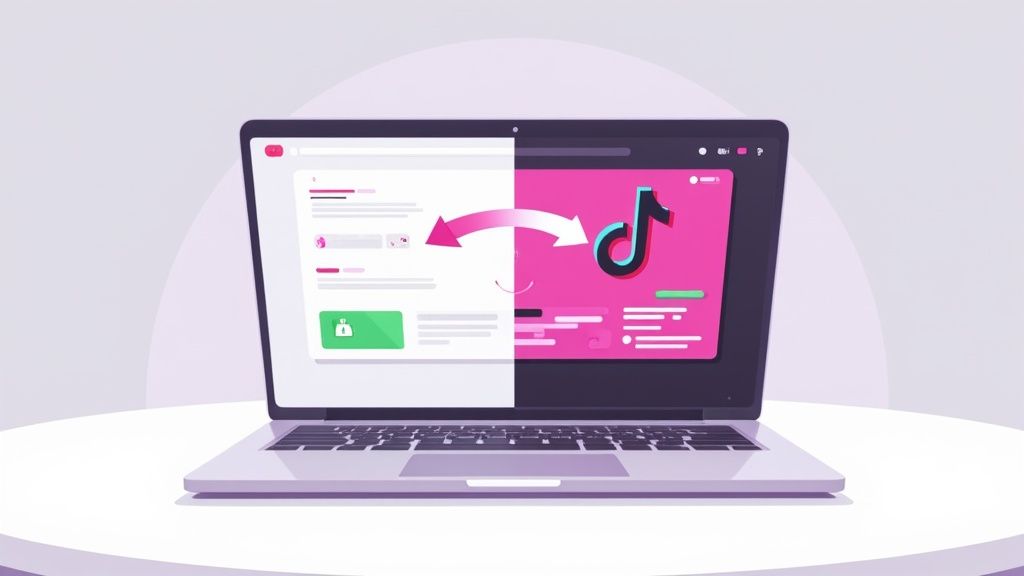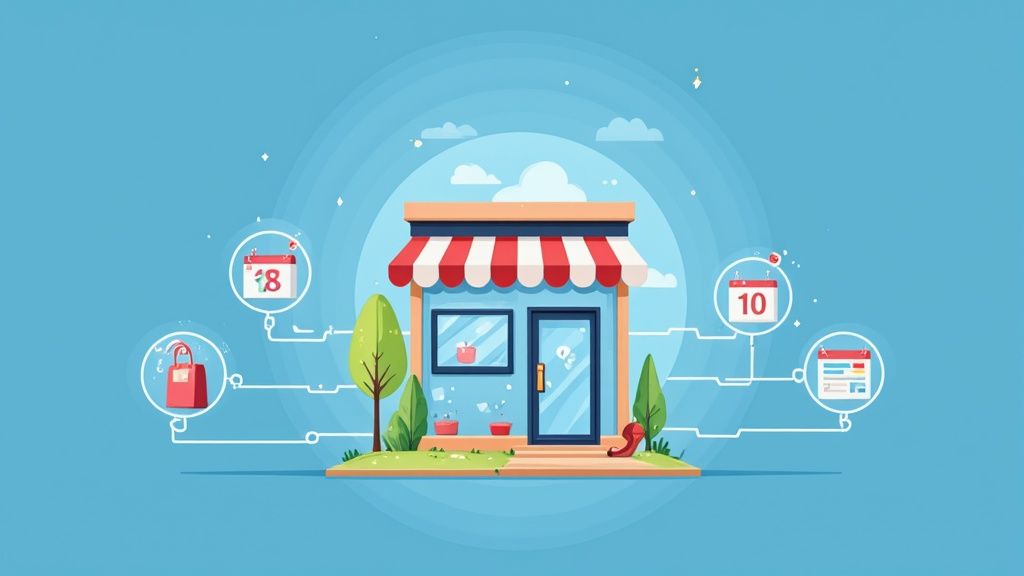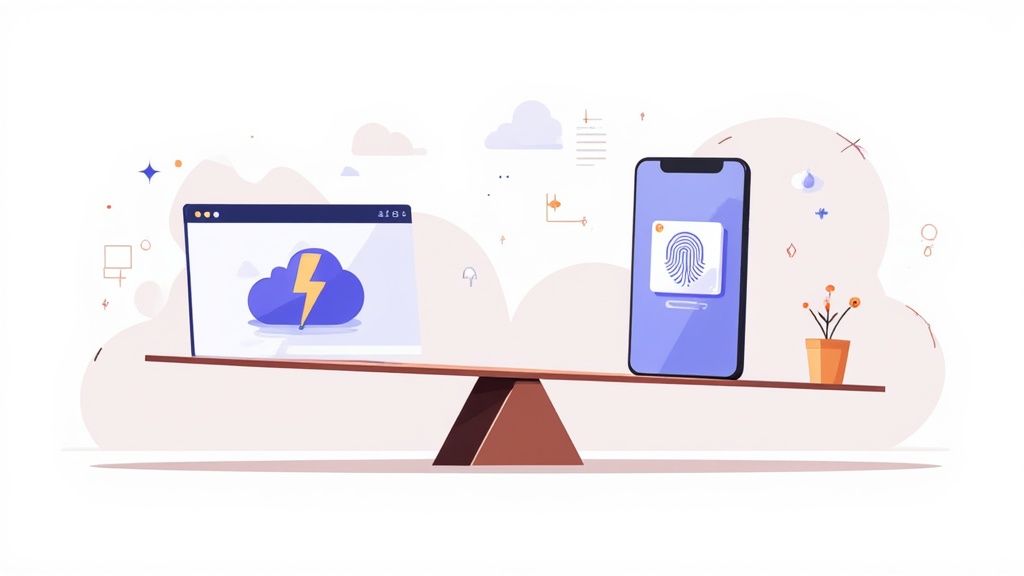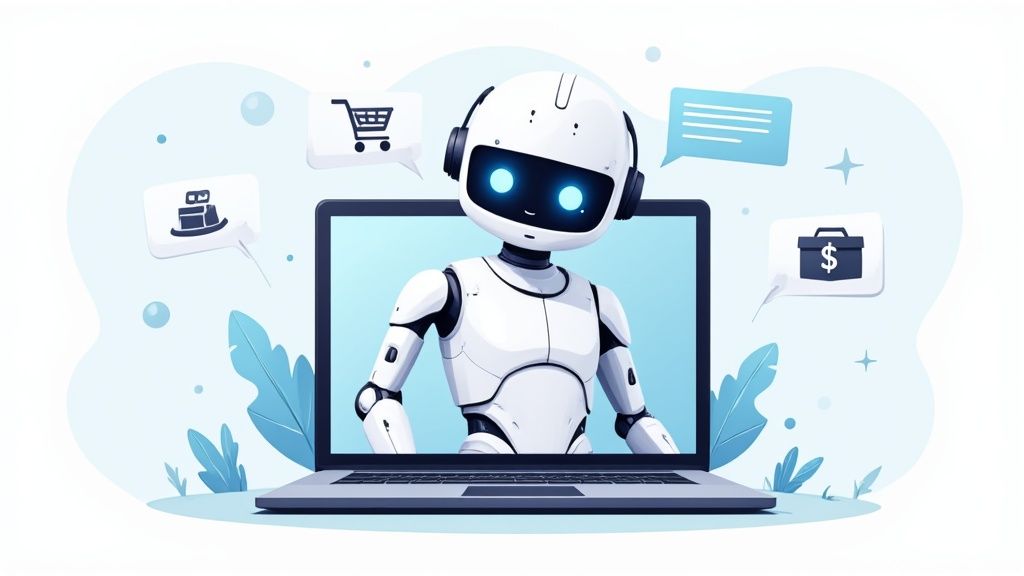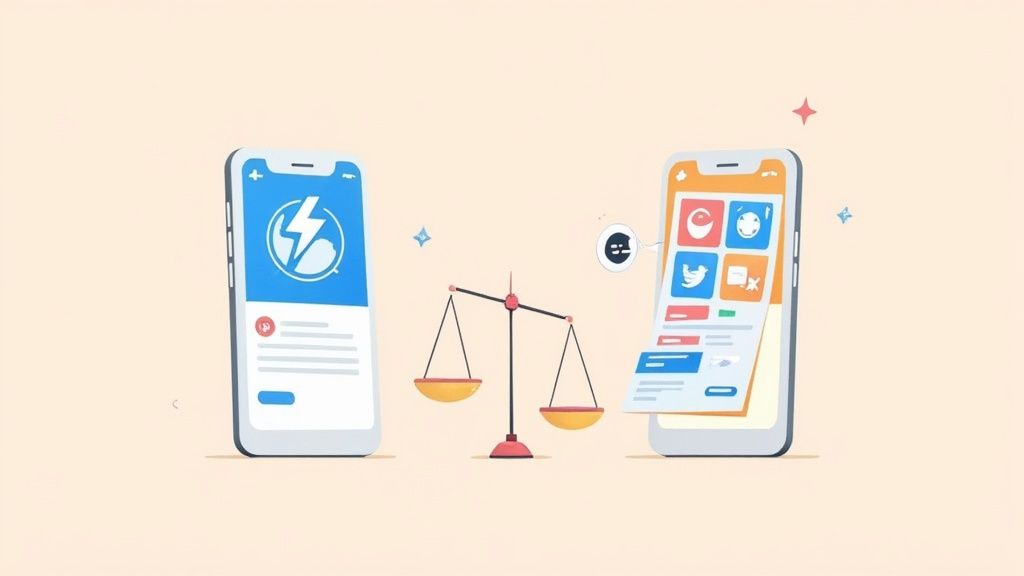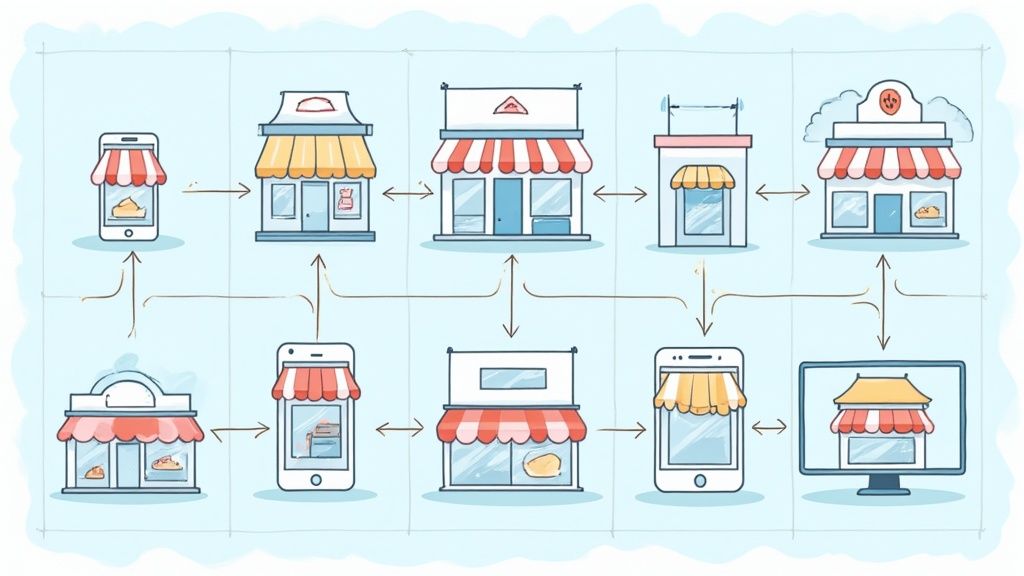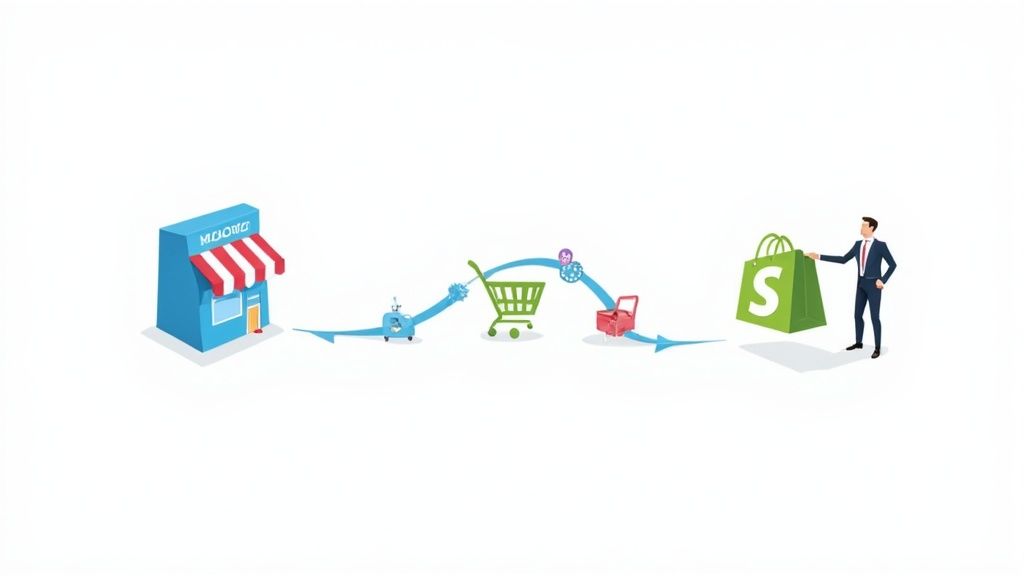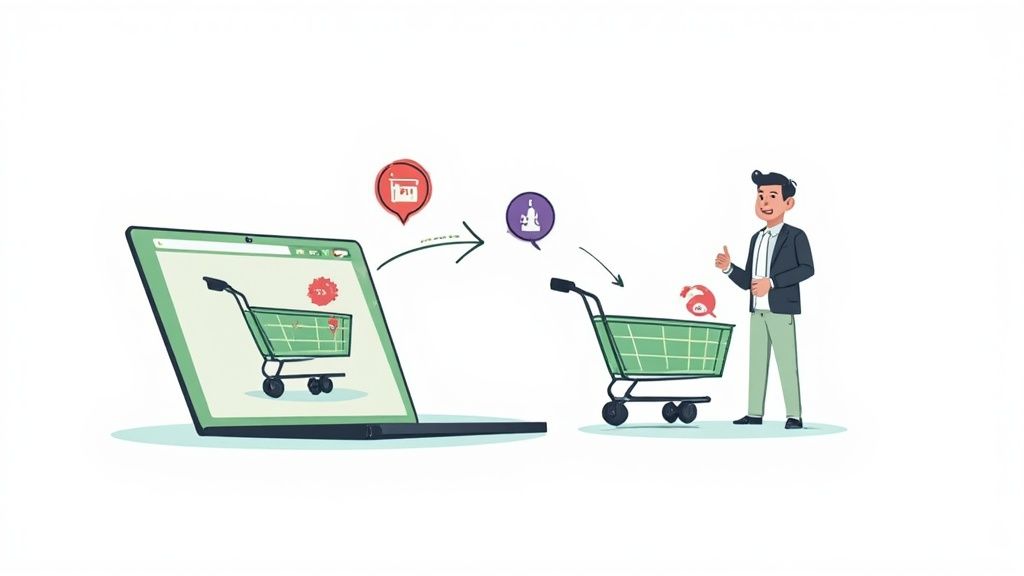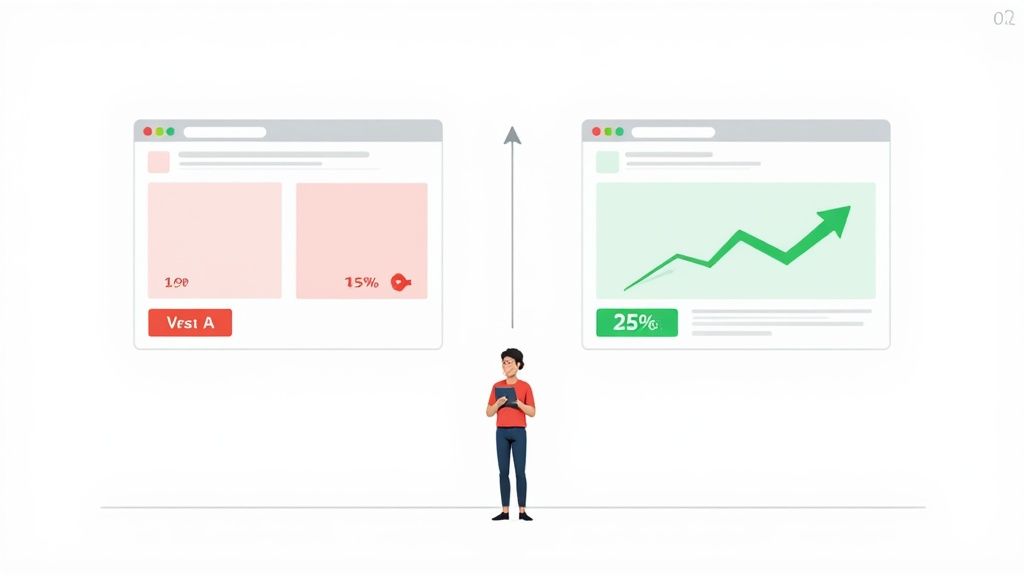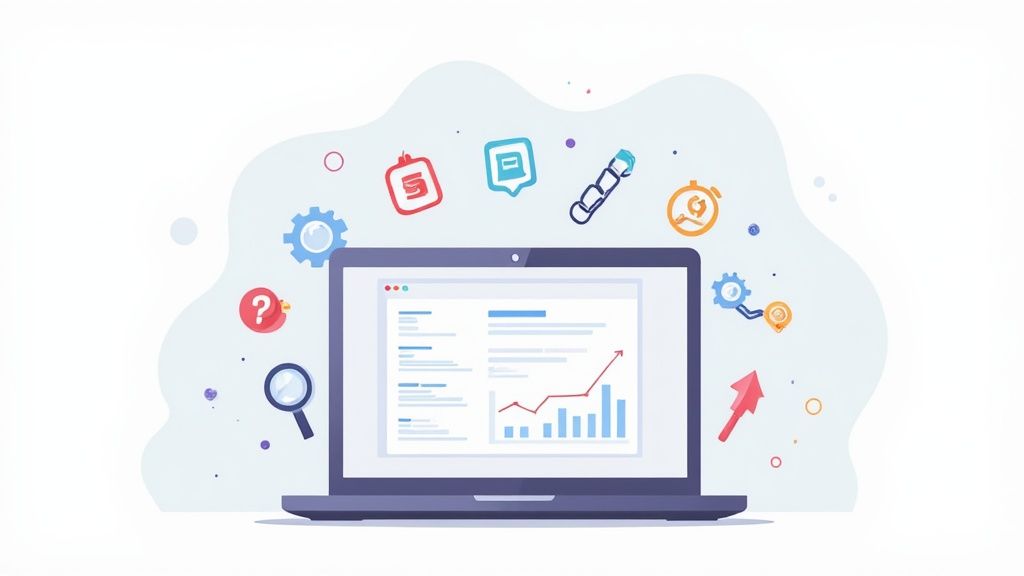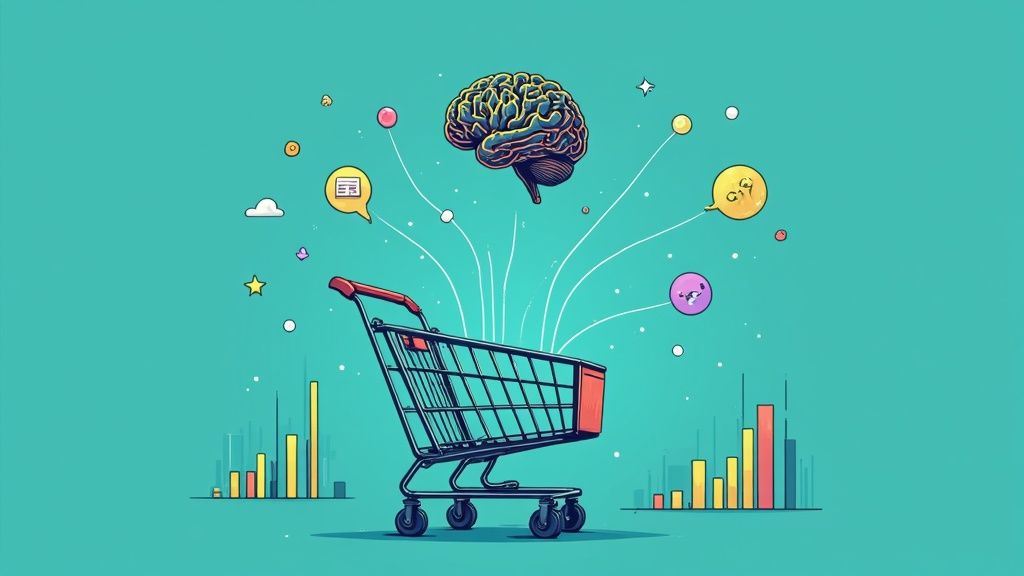
Improving your customer service isn't just about tweaking a few things here and there. It's about a fundamental shift in mindset—moving your support from a reactive cost center to a proactive growth engine. This means thoughtfully blending genuine human-led empathy with smart automation, making sure every single customer interaction is smooth, personal, and surprisingly efficient.
Why Exceptional Customer Service Matters More Than Ever

In a packed eCommerce world, your competitors can copy your product or match your price in a heartbeat. What they can't easily replicate is a genuinely superior service experience.
Today's shoppers have incredibly high expectations. They want fast, easy, and personalized help wherever they happen to be. Think about it: a single bad experience is enough for 64% of consumers to jump ship to a competitor. Every interaction is a make-or-break moment where you either build loyalty or lose a customer for good.
Great service is no longer about just solving problems—it's about creating an effortless journey that makes customers feel seen and valued. The old model of separate support teams and long hold times is dead. The game now is about building a cohesive system where technology empowers a well-trained team to deliver incredible results.
The Core Pillars of Modern Service
If you really want to level up your customer service, you need to build your strategy on three core pillars. When these work together, you create a system that’s not only efficient for your business but genuinely delightful for your customers.
- Effortless Omnichannel Experiences: Customers expect to start a conversation on live chat, follow up via email, and maybe even send a DM on social media without repeating themselves. A unified system makes this possible, keeping the conversation consistent and context-aware.
- Smart Automation and AI: Let technology handle the repetitive, low-value stuff like tracking orders or answering "What's your return policy?". This frees up your human agents to tackle the complex issues that actually require empathy and creative problem-solving. Understanding AI's role in transforming customer connection is a great starting point for seeing how tech can enhance, not replace, the human touch.
- An Empowered, Well-Trained Team: Your agents are the face and voice of your brand. Giving them the right tools, deep product knowledge, and solid soft-skills training isn't just a good idea—it's completely non-negotiable for success.
The bottom line is simple: great customer service is a growth center, not a cost center. It directly impacts revenue by increasing customer lifetime value and turning happy shoppers into your most powerful marketers.
By focusing on these areas, you stop just answering tickets. You start building a service operation that actively drives business growth and creates a competitive advantage that’s incredibly difficult for anyone else to copy.
Auditing Your Current Customer Service Performance
Before you can build a better customer service machine, you need to take a brutally honest look under the hood. To really improve, you first have to diagnose what’s actually broken. Think of this audit not as a finger-pointing exercise, but as gathering a clear, data-backed baseline to build from.
Jumping straight into solutions without this foundational knowledge is like trying to navigate a new city without a map. You might get there eventually, but you’ll waste a ton of time and energy on wrong turns. A proper audit helps you pinpoint the exact friction points your customers are hitting.
Moving Beyond Surface-Level Metrics
First things first: you have to collect and analyze your core customer service metrics. Plenty of stores track these, but very few dig deep enough to understand the stories the numbers are telling.
Start with the big three feedback surveys:
- Customer Satisfaction (CSAT): This measures happiness with a specific interaction. A low CSAT score on live chat, for example, could point to slow responses or an agent who needs more training. It's your immediate pulse check.
- Net Promoter Score (NPS): This is all about overall brand loyalty. It asks how likely a customer is to recommend you. A dropping NPS is a massive warning sign that bigger, systemic issues are starting to hurt your reputation.
- Customer Effort Score (CES): This one asks, "How easy was it to get your issue resolved?" A high effort score is a huge red flag. It means your processes are clunky and frustrating—a major cause of churn.
Looking at these together gives you a much richer picture. For instance, your CSAT might be high because your agents are incredibly friendly, but your CES is in the gutter because customers have to jump through hoops just to talk to someone. That tells you the team is great, but the systems are failing them.
Digging into Your Helpdesk Data
Your helpdesk is an absolute goldmine of qualitative data. This is where you find the "why" behind your metrics. Don't just glance at ticket volume; you need to analyze the tickets themselves by tagging them with common themes.
Let's say you find that 30% of your support tickets are tagged "Where is my order?" (WISMO). This isn't just a support problem—it’s an operational and communication failure. The solution isn't to hire more agents to answer the same question faster. The real fix is to improve your post-purchase email automation or add a self-service order tracking page to your site.
An audit reveals the root cause of your service issues. It helps you move from constantly putting out fires to strategically fireproofing your entire operation.
This process directly ties service improvements to the bottom line. Businesses that focus on customer experience can see revenue growth 4% to 8% above their market average. It’s no surprise that 80% of companies use CSAT to analyze their performance and 72% rely on analytics to refine their strategies. It just plain works. You can see more data on how top companies are tackling this in this detailed statistical report from HelpScout.
To get started, it's crucial to understand which numbers matter most. Below is a breakdown of the essential KPIs you should be tracking to diagnose your current performance.
Key Customer Service Metrics to Track
These metrics give you a comprehensive dashboard for your service health. By tracking them consistently, you can spot problems before they escalate and measure the true impact of the changes you make.
Conducting a Channel-by-Channel Review
Finally, you need to assess each of your support channels on their own. A customer's experience on live chat can be worlds apart from their experience over email or on social media.
For every channel you offer, ask these critical questions:
- Email: What’s our average first response time? How many back-and-forths does it usually take to solve an issue?
- Live Chat: What’s our chat abandonment rate? Are agents juggling too many chats at once and letting quality slip?
- Phone: What's the average time someone is stuck on hold? What percentage of calls are resolved on the first try (FCR)?
- Social Media: How fast are we replying to DMs and public comments? Is our tone on-brand and consistent?
This channel-specific breakdown will quickly expose the weak links in your support chain. You might find your email team is killing it, but your social media support is slow and inconsistent, creating a jarring experience. Once you have this complete picture, you'll know exactly where to focus your efforts for the biggest impact.
Designing a Seamless Omnichannel Support System
Modern customers don't live in neat little boxes. They might see your product on Instagram, pop over to your website's live chat with a question, and then email a few days later to check on their order. To them, it's all one conversation with your brand.
Forcing them to repeat themselves at every turn is one of the fastest ways to sour their experience.
This is where a true omnichannel support system comes in. It's about much more than just being active on different platforms; it's about weaving those platforms together so the conversation flows seamlessly with the customer. Getting this right is fundamental to improving customer service in a way that feels genuinely effortless.
Choosing Your Core Support Channels
First things first: you don't need to be everywhere. Spreading your team thin across a dozen channels is a surefire way to be mediocre on all of them. The smart move is to master the channels where your customers actually hang out.
For most eCommerce brands, that usually means a strategic mix of these core four:
- Live Chat: This is your front-line tool for real-time sales support and quick problem-solving. A well-placed chat widget can dismantle purchase hesitation on the spot and has a direct impact on conversion rates. If you want to dig deeper, we have a complete guide on how to turn your Shopify live chat into a sales machine.
- Email: The workhorse for more complex issues. It's perfect for handling things that require documentation, detailed follow-ups, and thoughtful responses that can't be rushed. Plus, you get a clear paper trail.
- Social Media (DMs & Comments): Increasingly vital for brand engagement and public-facing support. A quick, helpful reply to a comment on Instagram or a DM can be seen by hundreds of potential customers, amplifying its positive impact.
- Phone: While less common for purely digital brands, phone support is still a must-have for high-value products or for customers who just prefer talking to a real person—especially when things get complicated or urgent.
The goal isn't just to offer these channels; it's to connect them. A true omnichannel system ensures that when a customer hops from an Instagram DM to an email, your support agent sees the entire history instantly.
This unified view kills the dreaded, "Could you please explain your issue again?" question. It tells the customer you're paying attention and you value their time.
Unifying the Customer Conversation
The real magic behind omnichannel support happens when you integrate everything through a modern helpdesk like Gorgias, Zendesk, or Freshdesk. These tools act as a central hub, pulling conversations from every channel into a single, unified timeline for each customer.
Let's walk through a real-world example:
A customer sends you an Instagram DM asking if a dress will be restocked in her size. Your social media manager replies, "Yes, it'll be back next week! I can notify you." That entire exchange is automatically logged in your helpdesk.
A week later, that same customer emails your support address to ask for an update. The agent who gets the ticket immediately sees the prior Instagram chat. There's no fumbling around for context. They can just reply, "Hi Jane, thanks for following up! Great news—the dress you asked about on Instagram is back in stock. Here's a direct link to purchase."
That simple, seamless interaction transforms a routine question into a loyalty-building experience.
To make this a reality, you need a structured approach to find and fix the gaps between your channels. This is the basic workflow we follow.
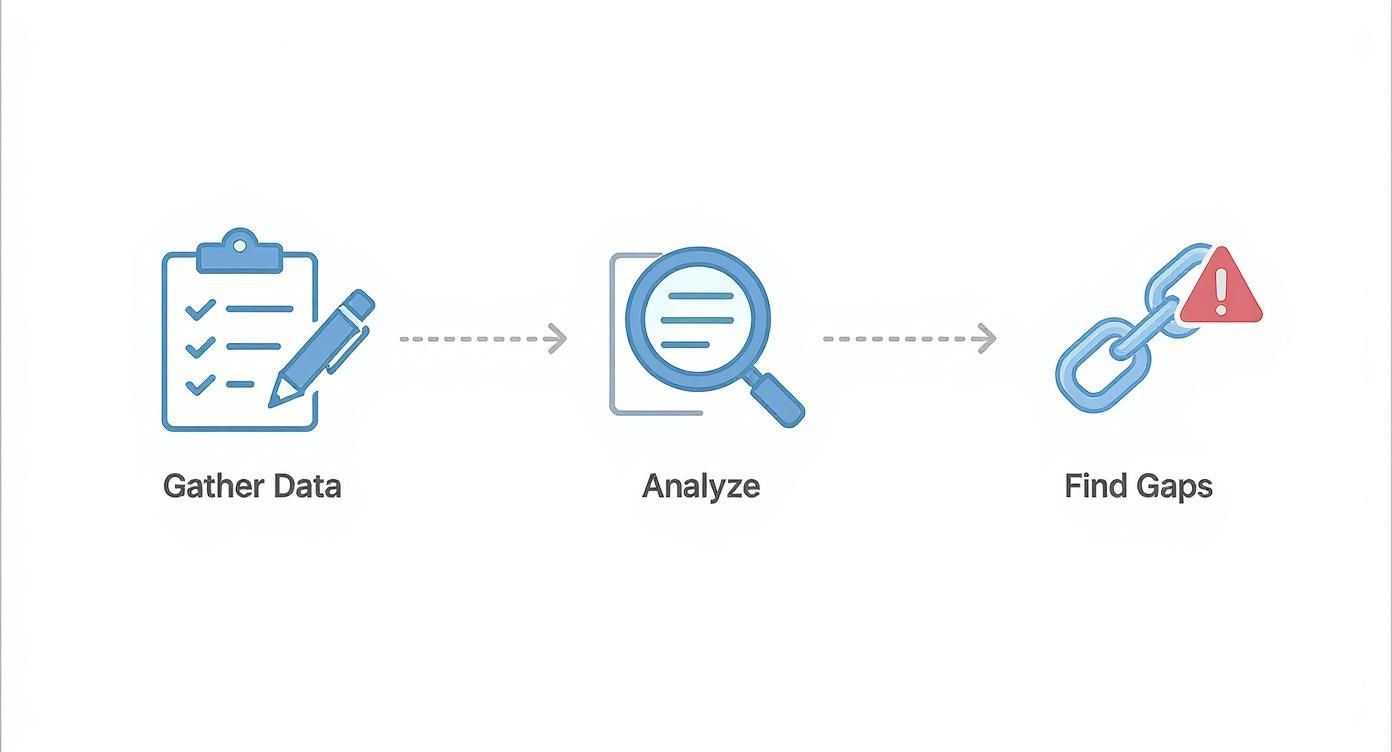
As you can see, improvement starts by gathering data from all your channels, analyzing it to map the full customer journey, and then zeroing in on where conversations break down. By auditing these flows, you can build consistency no matter how a customer decides to reach out, making your support feel cohesive, intelligent, and worthy of their trust.
Using Automation and AI to Scale Your Support

As your brand grows, simply hiring more support agents isn't a scalable solution. Your costs will balloon, and you'll spend more time training than improving. The real key to handling more customers efficiently is to get smart with automation and AI.
Think of it as augmenting your human team, not replacing them. This approach allows you to deliver instant, consistent answers to routine questions while freeing up your seasoned experts for the high-stakes conversations that truly matter.
The goal is a perfect harmony between technology and people. AI becomes your team's most reliable assistant—it works 24/7, never gets tired, and crushes the repetitive tasks that drain your best agents' energy. It's a non-negotiable step if you want to scale your service without your budget spiraling out of control.
High-Impact Automation for Immediate Wins
You can make a huge difference, fast, by automating the most common, low-effort questions. These are the tickets that constantly flood your inbox but don't require deep, creative problem-solving.
Look for the low-hanging fruit:
- Order Status Inquiries: Instead of an agent manually looking up an order, a chatbot or automated workflow can instantly pull tracking info with just a customer's email or order number.
- Return Policy Questions: Set up an automated reply that clearly explains your return policy and provides a direct link to your returns portal. No agent needed.
- Basic Product FAQs: Use a chatbot to answer simple questions like "Is this product waterproof?" by pulling data straight from your product pages.
Automating these interactions gives customers the instant answers they crave and buys back precious time for your team. This shifts your agents from being reactive information-finders to proactive problem-solvers.
The smartest way to use automation is to kill the mundane. When bots handle the simple, repetitive stuff, you empower your human agents to pour their expertise into complex issues that actually require a human touch.
This isn't just about efficiency. It's a strategic move to elevate the quality of every single interaction. Customers with simple questions get immediate help, while those with tougher problems get a focused, empathetic agent who has the mental space to deliver a truly exceptional experience.
Leveraging AI to Augment Your Agents
Going beyond basic automation, modern AI tools can act as a powerful co-pilot for your support team, making them faster and more effective. The right AI integration doesn’t just close tickets; it amplifies the skills of your people.
Here's how it works in practice:
- Ticket Tagging and Routing: AI can read an incoming ticket, understand its intent (e.g., "return," "damaged item," "shipping question"), and automatically tag and route it to the right person or department. This eliminates manual triage and gets tickets solved faster.
- AI-Suggested Responses: When an agent opens a ticket, AI can suggest relevant macros or help center articles based on the customer's question. This ensures consistency and dramatically speeds up replies, but the agent still has full control to personalize the final message.
- Real-Time Sentiment Analysis: Some tools can analyze a customer's language during a live chat to gauge their emotional state—frustrated, happy, or confused. This gives agents a valuable heads-up, letting them adjust their tone to de-escalate a tricky situation before it blows up.
The Financial and Experiential Case for AI
Let's be clear: implementing this technology is no longer optional. Projections show that by 2025, a staggering 95% of all customer interactions will be touched by AI in some way. This is happening because it delivers what customers demand: speed and personalization. In fact, 70% of customer experience leaders already say generative AI makes their digital support more efficient. You can dive deeper into how to effectively deploy AI customer service chatbots in our dedicated guide.
The financial incentive is just as strong. With 68% of consumers willing to pay more for a brand with great service, investing in AI-driven efficiency is not just about cutting costs—it's a direct path to boosting revenue and building loyalty. By bringing AI and automation into your support stack, you build an operation that's not only scalable and efficient but also laser-focused on delivering the quality human experiences that make a brand unforgettable.
Equipping Your Team with the Right Tools and Training
Your helpdesk and AI tools are powerful, but they're only half of the picture. Technology is just a force multiplier; the real heart of your customer service is your people. Empowering them with the right skills and a supportive environment is the most direct path to creating experiences that customers remember and talk about.
An untrained agent with the best software is still an untrained agent. They'll be slow, inconsistent, and lack the confidence to solve problems effectively. Investing in your team’s development isn't just a line item in your budget; it’s a direct investment in customer loyalty and retention.
Building a Robust Training Program
A truly effective training program goes far beyond just showing agents how to use your helpdesk. It has to be a holistic system that covers product knowledge, company processes, and the essential soft skills that separate mediocre service from exceptional service.
Think of your training as having two core components:
- Hard Skills: This is the technical foundation. Agents need to know your products inside and out. They must be experts on your shipping policies, return procedures, and warranty information. This knowledge is non-negotiable and forms the bedrock of competent support.
- Soft Skills: This is where the magic happens. Soft skills are what allow agents to connect with customers on a human level. These are the abilities that build trust and de-escalate tension, turning a frustrating situation into a positive one.
Training isn't a one-time event during onboarding. It's a continuous process. Your products will change, your policies will evolve, and your team’s skills will need constant sharpening to stay at the top of their game.
Mastering Essential Soft Skills for Support
While product knowledge allows an agent to answer a question, soft skills allow them to solve the customer's problem. Focus your ongoing coaching on these key areas.
- Active Listening: This means paying full attention to what a customer is saying—and what they aren't saying. It’s about digging into the root of their frustration, not just the surface-level issue.
- Empathy: The ability to genuinely understand and share a customer's feelings is perhaps the most critical skill of all. An empathetic response like, "I can see how frustrating it must be to receive a damaged item," immediately validates their feelings and shows you're on their side.
- Clear Communication: Great agents are masters of clarity. They avoid jargon, use positive language, and confirm the customer understands the resolution. The goal is to leave zero room for misunderstanding.
- Conflict De-escalation: When a customer is angry, a well-trained agent knows how to stay calm, listen patiently, and steer the conversation toward a productive outcome instead of getting defensive.
Investing in formal education can also give your team a huge boost. Look into courses on advanced customer service skills to create structured learning paths for your top performers.
Creating an Internal Knowledge Base
Your best agents can't be everywhere at once, but their knowledge can be. An internal knowledge base is your team's centralized library of information—a single source of truth for processes, troubleshooting steps, and canned responses for common questions.
A well-maintained knowledge base does two things incredibly well:
- It ensures consistency. Every customer gets the same, correct answer, no matter who they talk to.
- It boosts efficiency. Agents can find answers in seconds instead of having to ask a manager or coworker, which drastically cuts down handle times.
Fostering a Supportive Team Culture
Finally, agent burnout is a real and costly problem. High turnover means you're constantly losing valuable institutional knowledge and spending more resources on hiring and retraining. The best way to combat this is by building a culture that truly supports your team.
This means providing clear career paths, celebrating wins, and protecting your agents from unreasonable customer demands. A supportive environment leads to happier, more engaged agents who are motivated to go the extra mile. They feel valued, which in turn makes them better at making your customers feel valued. This positive cycle is the foundation of a world-class service operation that lasts.
Creating a Cycle of Continuous Improvement
Exceptional customer service isn't a project with a finish line. You don't just "complete" it and move on. The brands that truly stand out treat it as a constant process of refinement—a loop of listening to customers, measuring what matters, and making small, consistent improvements. This is how you start turning your support team from a cost center into a powerful, data-driven engine for loyalty.
Building this feedback loop is the key to shifting from a reactive mindset (fixing today's problems) to a proactive one (preventing tomorrow's). It keeps your team, your tools, and your processes sharp and always in sync with what your customers actually expect. This commitment is what separates merely good support from truly memorable service.
Monitoring Performance with Dashboards
To actually see if all your changes are making a difference, you need a clear, daily view of your key performance indicators (KPIs). Instead of drowning in spreadsheets, the best move is to set up a central performance dashboard right in your helpdesk or a business intelligence tool. This gives everyone an at-a-glance snapshot of the team's health.
You don’t need a hundred metrics. Focus on the core ones you picked during your initial audit:
- First Contact Resolution (FCR): Is this number climbing? A rising FCR is a strong signal that your training and new workflows are working, empowering agents to solve issues on the first try.
- Average Handle Time (AHT): Is AHT going down without tanking your CSAT scores? If so, it means your automation and knowledge base are actually making agents more efficient, not just rushing them.
- Customer Satisfaction (CSAT): This is your ultimate source of truth. If your CSAT scores are ticking up, you know for a fact that your efforts are hitting the mark and making customers happier.
Implementing Regular Quality Assurance
Metrics tell you what happened, but quality assurance (QA) is how you find out why. QA is just a systematic way of reviewing a sample of support tickets to see how your team is performing against your standards. This isn't about micromanaging or catching people making mistakes; it's about spotting opportunities for coaching and growth.
Start with a simple QA scorecard that grades tickets on a few key criteria. Things like:
- Was the solution provided accurate and complete?
- Did the agent stick to our brand voice and tone?
- Was there a genuine show of empathy and active listening?
Just reviewing a small number of tickets—say, 3-5 per agent per week—gives you a goldmine of concrete examples to bring into one-on-one coaching sessions. Suddenly, every customer interaction becomes a potential lesson, building a culture where everyone is obsessed with getting a little better every day.
This cycle of data-driven feedback is what makes it all stick. It creates accountability and, just as importantly, shows your team that their hard work is being measured and valued. It directly connects their day-to-day efforts to the company's big-picture success.
Things are always changing. Autonomous customer service, powered by AI, is projected to handle 80% of customer issues by 2025. That sounds great, but the reality is that with only 12% of self-service platforms being highly integrated today, a mere 20% of issues get fully resolved without an agent. To keep up, you have to constantly fine-tune how your human team and automated systems collaborate. You can discover more insights on 2025 customer support trends and see just how critical this cycle of improvement really is.
Common Questions Answered
When you're deep in the trenches of refining your customer service, a few practical questions always seem to pop up. Let's tackle some of the most common ones we hear from eCommerce brands.
What’s the Single Most Important Metric to Track?
If I had to pick just one, it would be Customer Satisfaction (CSAT). While there are tons of valuable metrics, CSAT gives you the most immediate, gut-check feedback on how you're doing.
It’s simple: after an interaction, you ask the customer how satisfied they were. This allows you to instantly flag issues with a specific agent, a confusing policy, or a broken process. Think of it as a real-time pulse check on your service quality, letting you fix small problems before they become big ones.
How Can a Small Store Improve Service Without a Big Budget?
You don't need a huge budget to deliver incredible service. It's all about being smart, proactive, and human.
- Build a killer FAQ page: Seriously. A detailed, easy-to-navigate FAQ page can head off a massive number of common questions, freeing you up for more complex issues.
- Lean on email automation: Set up simple flows to keep customers in the loop about their order status—when it’s received, shipped, and delivered. It's a small touch that makes a huge difference.
- Get an affordable helpdesk: Even a basic tool can bring order to the chaos of customer emails and messages. Organization is key.
The most powerful tool any store has—regardless of size—is a genuine human touch. Training your team to be exceptionally empathetic and resourceful costs nothing but is absolutely priceless to a customer. It will always beat out expensive software.
Should We Use Chatbots or Stick with Human Agents?
This isn't an "either/or" situation. The best strategy for a growing business is almost always a hybrid approach where chatbots and humans work together.
Let chatbots handle the simple, repetitive stuff 24/7, like tracking an order ("Where's my stuff?") or answering basic questions about your return policy. This gives customers instant answers around the clock.
This frees up your human agents to tackle the conversations that truly matter—the complex, emotional, or high-value inquiries where empathy and creative problem-solving are essential. It's the perfect blend of speed and quality, and it leads to a much better experience for everyone.
At ECORN, we specialize in building scalable Shopify solutions that grow with your brand. From optimizing your storefront for conversions to developing custom apps, we provide the expertise to turn your customer service into a competitive advantage. Explore our flexible subscription packages and see how we can help you grow.






